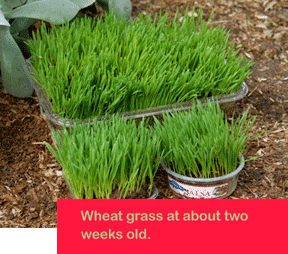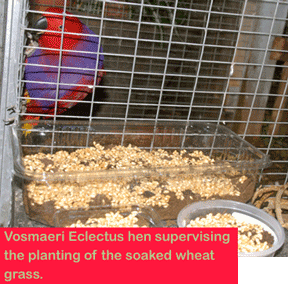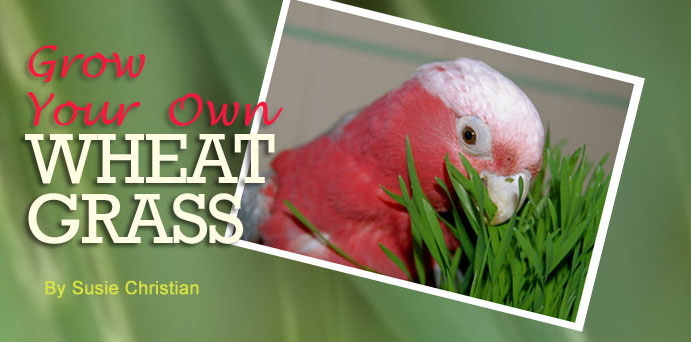 Once the wheat is planted, I keep the trays in indirect sunlight with a temperature of 70 degrees or a little more, for 7 to 10 days, and I water them lightly daily so the soil doesn’t dry out.
Once the wheat is planted, I keep the trays in indirect sunlight with a temperature of 70 degrees or a little more, for 7 to 10 days, and I water them lightly daily so the soil doesn’t dry out.
The amount of soil you originally use is up to you, but the reality is that as your wheat plants grow, they need more and more water. They get their water from the soil, and the more soil you use, the more water the growing tray can hold, hence you need to water less if the soil depth is more.
One thing to watch for is the possibility of mould or fungus, and this can be avoided by planting a smaller amount of grain at a time. The hotter and more humid your climate is, the more of an issue mold and fungus are. Not enough air circulation can also cause mould problems, so again, make sure enough holes are in the tray bottoms. The more densely you plant the seed, the less air circulates around the individual blades of grass.
When the grass is about 6 to7 inches tall, it is ready to be harvested or used as a treat for the birds, eaten directly from the flats. I try to cut the grass blades very close to the soil when harvesting, because the birds enjoy the base of the grass stalk, much more than the tips of the grass. Anything in the way of produce that is crunchy and full of substance is preferred.
The trays of wheat grass, after harvesting, can produce a second and even third crop, so you may continue to water the tray after you cut your first crop. The second and more so the third crop, is not as tender and won’t usually grow as big, but it is worth trying at least, to grow a second crop.
 Wheat grass doesn’t take a lot of time or effort to grow, and many people who aren’t into growing things love to grow it. Propagation can also become a great science project for children, as well as a source for pet food. I have seen how the parrots here relish the fresh wheat grass blades, but cats, dogs, hamsters, guinea pigs and rabbits can also benefit from a happy graze of this living, fresh treat. Purchased at the store, containers of wheat grass can cost four or five dollars, but we can grow our own for a few pennies and a little effort. Your birds and other pets will thank you.
Wheat grass doesn’t take a lot of time or effort to grow, and many people who aren’t into growing things love to grow it. Propagation can also become a great science project for children, as well as a source for pet food. I have seen how the parrots here relish the fresh wheat grass blades, but cats, dogs, hamsters, guinea pigs and rabbits can also benefit from a happy graze of this living, fresh treat. Purchased at the store, containers of wheat grass can cost four or five dollars, but we can grow our own for a few pennies and a little effort. Your birds and other pets will thank you.
Next: Sprouting Tips

 Once the wheat is planted, I keep the trays in indirect sunlight with a temperature of 70 degrees or a little more, for 7 to 10 days, and I water them lightly daily so the soil doesn’t dry out.
Once the wheat is planted, I keep the trays in indirect sunlight with a temperature of 70 degrees or a little more, for 7 to 10 days, and I water them lightly daily so the soil doesn’t dry out. Wheat grass doesn’t take a lot of time or effort to grow, and many people who aren’t into growing things love to grow it. Propagation can also become a great science project for children, as well as a source for pet food. I have seen how the parrots here relish the fresh wheat grass blades, but cats, dogs, hamsters, guinea pigs and rabbits can also benefit from a happy graze of this living, fresh treat. Purchased at the store, containers of wheat grass can cost four or five dollars, but we can grow our own for a few pennies and a little effort. Your birds and other pets will thank you.
Wheat grass doesn’t take a lot of time or effort to grow, and many people who aren’t into growing things love to grow it. Propagation can also become a great science project for children, as well as a source for pet food. I have seen how the parrots here relish the fresh wheat grass blades, but cats, dogs, hamsters, guinea pigs and rabbits can also benefit from a happy graze of this living, fresh treat. Purchased at the store, containers of wheat grass can cost four or five dollars, but we can grow our own for a few pennies and a little effort. Your birds and other pets will thank you.